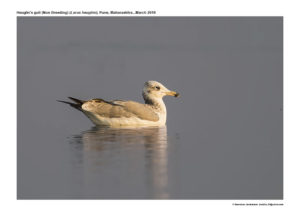Heuglins Gull

Heuglin’s Gull Larus heuglini
Etymology:
- Larus : Latin word for rapacious seabird
- Heuglini : Named after German ornithologist Martin Theodor von Heuglin (1824–1876)
Vernacular Names: Mar: Huglin cha kurav, Pun: Chhota damra, Guj: Kalipith dhomado
Distribution in India: Winter visitor in Western coast and cost of Tamilnadu in India.
Description: Size of 58-65 cm; wt. of 550–1200 g; wingspan of 124–158 cm. It is a medium-sized, slenderer gull, with a more rounded head, slightly thinner and more drooping bill, and longer, narrower, more pointed wings, giving a more attenuated appearance at rest. The breeding adult has a dark-mantled, yellow-legged gull; bill yellow, with red gonydeal spot; iris yellow, with red orbital ring. Non-breeding adult has head and neck less heavily streaked.
Habitat:
It is found in coastal and inland waters. It congregates to feed or roost at estuaries, harbours, lakes, reservoirs and sandy beaches. Many scavenge at rubbish dumps and in fields.
Food Habits: It eats small fish, aquatic invertebrates, birds’ eggs and chicks, trawler discards, rodents and berries. The foraging methods include contact-dipping and surface-plunging.
Breeding Habits: They breed in April- June in tundra of northern Russia from the Kola Peninsula east to the Taymyr Peninsula and Finland. It breeds mainly on sandy, rocky or grassy sea coasts, rocky islands, in saltmarshes, on islands in lakes and rivers. The nest is made of dry stalks, grass, lichens and feathers. They lay a clutch of 2-3 eggs. The incubation period is 24-28 days. The fledging period is 30-40 days.